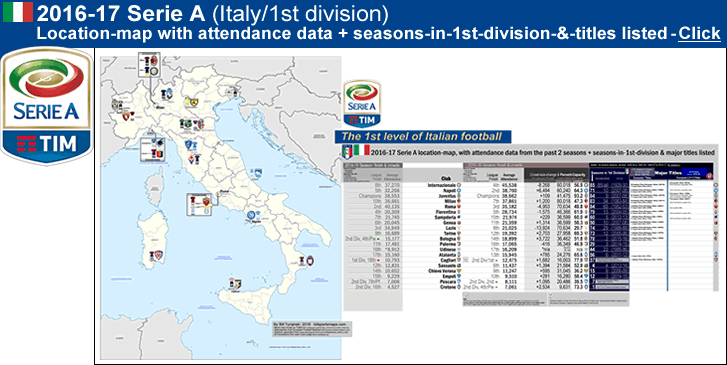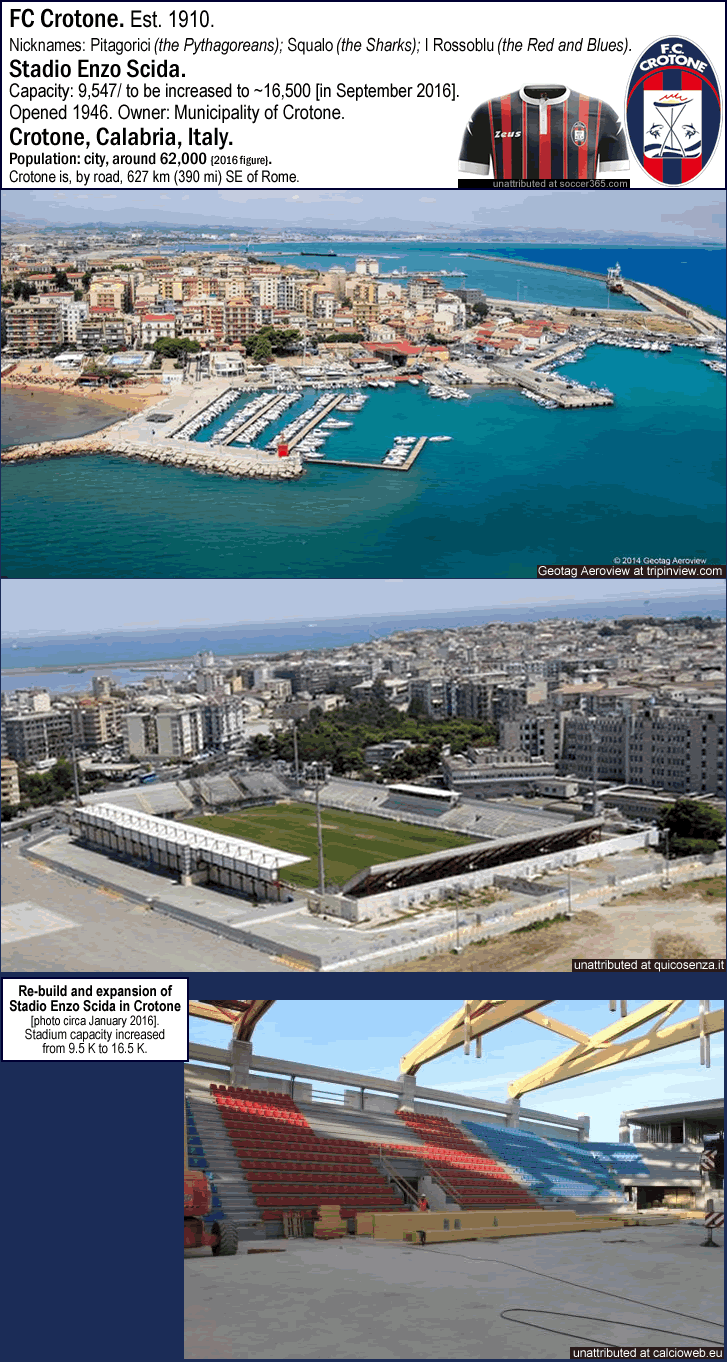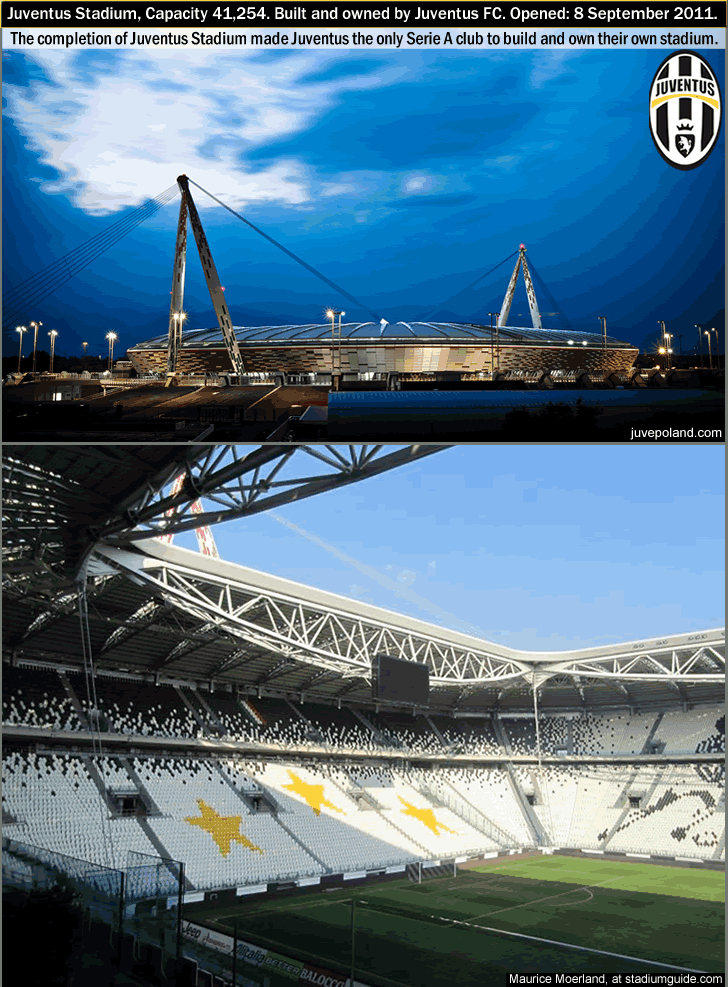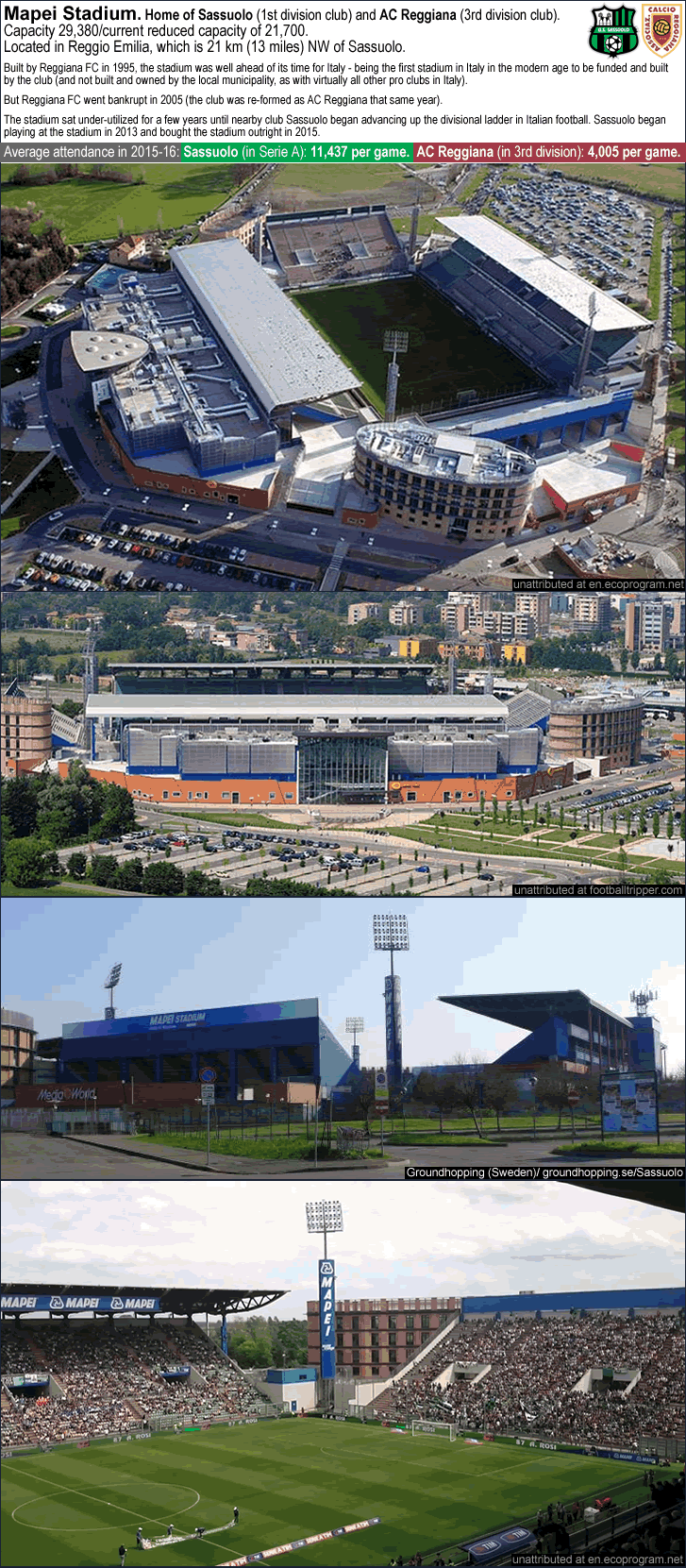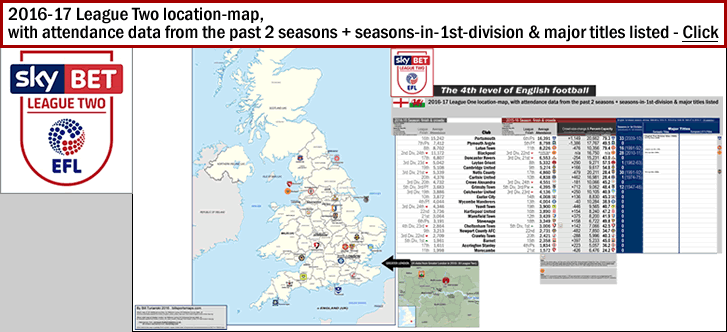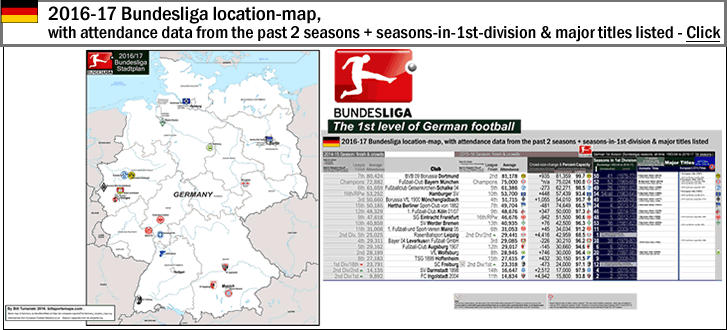
Germany: 2016-17 Bundesliga location-map, with: 15/16 attendance data, seasons-in-1st-division-by-club & major titles listed
…
…
By Bill Turianski on 30 September 2016; twitter.com/billsportsmaps.
Links…
-Teams, etc…2016-17 Bundesliga (en.wikipedia.org).
-English-speaking Bundesliga coverage…bundesligafanatic.com.
-Official site of the Bundesliga in English (offizielle webseite der Bundesliga)…bundesliga.com/en/.
-Table, fixtures, results, stats, etc…Bundesliga – Summary (soccerway.com/national/germany/bundesliga).
…
-
Below: the 2 promoted clubs from 2.Bundesliga to the Bundesliga for 2016-17
(SC Freiburg, RB Leipzig)…
-
• SC Freiberg
(Est. 1904). City-population of Freiburg im Breisgau: around 220,000 {2014 figure}. Freiburg is, by road, 205 km (127 mi) SW of Stuttgart. Freiburg is, by road, 70 km (44 mi) N of Basel, Switzerland.
Colours: Red-with-Black. Nickname: (none). Coach: Christian Streich (age 51), born in Weil am Rhein, SW Baden-Württemberg.
-From Bundesliga official site, from May 2016, Youth-oriented Freiburg are back. After relegation to 2.Bundesliga in May 2015, SC Freiburg retained their coach, Christian Streich, and much of their young squad. In 2015-16, they bounced straight back up to the Bundesliga with relative ease, clinching automatic promotion with 2 games to spare. Seen below are the top two scoring threats for Freiburg last season: Nils Petersen and Vincenzo Grifo. Both return for 2016-17.
Counting 2016-17, Freiburg have spent 12 seasons in the Bundresliga…
Freiburg’s previous stint in the top flight was a 6-season spell from 2009-10 to 2015-16. Freiburg’s fanbase is pretty faithful, seeing as how the club these days pretty much always plays to near-capacity (above 97 percent-capacity since 2012-13 [4 seasons]). The club saw barely any drop-off in attendance at all when they were down in the second division last season (in 2015-16). Last season Freiburg drew 23.3 K in a 24.0-capacity stadium, and they only drew 473 less than they were drawing in the 1st division in 14/15. That less-than-one-percent drop-off in crowd-size reminds me of Norwich City. Norwich City also loses less than one-percent of their crowd-size when they (invariably) get relegated. So SC Freiburg are kind of like Norwich City in that way. Plus both clubs are from relatively small cities to be having a 1st division team (some seasons), and both clubs are from cities which are tucked in somewhat outlying corners of their respective countries.
Freiburg im Breisgau is located in far south-western Germany, about 18 km (11 mi) E of the French border, and about 67 km (42 mi) N of the Swiss border. Freiburg is situated on the western edge of the Black Forest, and the city is located within the Baden wine-growing region. Freiburg has one of the highest standards of living in Germany, and is renowned for its advanced environmental practices. An example of how green and eco-conscious Freiburg is can be seen in the fact that in 1996, SC Freiburg were the first football club in Germany to install solar panels on their stadium (on three-quarters of the roof-space [see photo below]). Freiburg is so green that the coach, Christian Streich (a Freiburg-area native), rides his bicycle to the team’s home games at the Schwarzwald-Stadion.
-From the Transition site [an academic site],
The Future for SC Freiburg’s stadium is still bright (by Jessica Porter on 24 June 2015 at transition.web.unc.edu).

Photo and Image credits -
16/17 Freiburg jersey, photo unattributed at 3.bp.blogspot.com. Freiburg, aerial photo by Thomas Maier at File:Freiburg-im-Breisgau-Luftaufnahme-16072004.jpg. Schwarzwald-Stadion, aerial shot, photo by badenova.de. Schwarzwald-Stadion, interior shot, photo by Picture Alliance via kicker.de. Photo of Vincenzo Grifo, photo by Joachim Hahne at suedkurier.de/sport/sport/Spielernoten-So-stuermte-der-SC-Freiburg-an-die-Spitze. Nils Petersen, photo by Alexander Scheuber/Bongarts via zimbio.com. Photo of Freiburg players still celebrating during post-game press conference of coach Christian Srteich, image from screenshot of animated gif at kretschmannland.files.wordpress.com/2016/04/sc_freiburg_celebrate_promotion_29_04_2016.gif; kretschmannland.wordpress.com/category/the-daily-prompt/page/2/.
…
-
• RasenBallsport Leipzig
(Est. 2009). City-population of Leipzig: around 560,000; metro-area population: around 1.0 million/ 10th-largest city in Germany {2015 figures}. Leipzig is, by road, 149 km (93 mi) SSW of Berlin. Leipzig is, by road, about 152 km (95 mi) ENE of the Czech Republic border at the Ore Mountains (Erzgebirge).
Colours: White-with-Taurine-Red-and-Dark-Blue-and-Gummy-Bear-Yellow. Nickname: die Roten Bullen (the Red Bulls). Manager: Ralph Hasenhüttl (age 49), born in Graz, Austria.
Only 5 teams from the former-East-Germany have ever played in the Bundesliga (1991-92 to 2016-17)…
RB Leipzig are the first team from the former-East-Germany to play in the Bundesliga in almost a decade, since Energie Cottbus (who were last in the German top flight in 2008-09). Now, counting RB Leipzig, since German reunification/football-leagues consolidation in 1991-92 (when the top 2 teams in the last season of DDR-Oberliga were promoted over into the Bundesliga), only 5 teams from the former-East-Germany have ever played in the Bundesliga…
•Hansa Rostok (12 seasons in Bundesliga, last in 2007-08),
•Dynamo Dresden (4 seasons in Bundesliga, from 1991-95),
•VfB Leipzig (one season in Bundesliga in 1993-4),
•Energie Cottbus (6 seasons in Bundesliga, last in 2008-09),
•and now, RB Leipzig.
RB Leipzig make their first-division debut in 2016-17. Seen further below are the top four scoring threats for RB Leipzig last season, when they finished in second place in 2.Bundesliga, clinching automatic promotion with one game to spare (by beating Karslruhrer 2-0 on 8 May 2016).
And for the first time in 22 years, there finally is a team in the Bundesliga from the 6th-largest metro-region in Germany – the Central German Metropolitan Region (Leipzig/Chemnitz/Halle/Dresden: population of around 4.6 million {2009 figure}, see this, Metropolitan regions in Germany). (The previous team in the Bundesliga from this metro-region was Dynamo Dresden, who last played in the Bundesliga from 1991-95.)
That is the good news. The rest is good news only if you like the concept of corporations taking over the sports world…
That is because the seven-year-old “club” RB Leipzig is part of the Red Bull pro sports empire, which is growing like a cancer. From Guardian/football, from 8 September 2016, by Phillp Oltermann, How RB Leipzig became the most hated club in German football (theguardian.com/football). From the Supporters Not Customers site, Against Red Bull Football (by Ben Dudley on 11 June 2013 at supportersnotcustomers.com).
In most of the following cases below, the energy-drink purveyors Red Bull took over a football club, changed its colours, crest, and name, thereby stripping the club of its history and re-branding it in the name of further corporate conquest. Three other teams were founded by Red Bull GmbH (a minor-league soccer team in NYC, a 5th-division Brazilian side, and a now-defunct Ghanain team)…

Image above originally appears as result of search query “red bull football teams” at google.com.
Football “clubs” and soccer franchises that Red Bull GmbH owns…
-RB Leipzig (Leipzig, Saxony, Germany/1st div/est 2009, re-branded from a club which dated back to 1990 [SSV Markranstädt].
-Red Bull Salzburg (Salzburg, Austria/1st div/est 2005, re-branded from a club which dated back to 1933 [SV Austria Salzburg]) (now is merely a feeder-”club” for RB Leipzig).
-New York Red Bulls (Harrison, New Jersey, USA/1st div [Major League Soccer]/est 2006, re-branded from a franchise which dated back to 1995 [the NY/NJ MetroStars]).
-FC Liefering (Grödig, Greater Salzburg, Austria/2nd div/est 2012, re-branded from a club which dated back to 1947 [FC Anif]) (feeder-”club” for other Red Bull teams).
The following are teams which Red Bull started from scratch…
-Red Bull Brasil (Campinas, São Paulo, Brazil/4th div/est 2007).
-Red Bull Ghana (2008-14/defunct).
-New York Red Bulls II (Harrison, New Jersey, USA/quasi-3rd div/est 2015) (feeder-minor-league-team in USL-1, for the New York Red Bulls of MLS).
-(Red Bull GmbH also owns 1st-division ice hockey teams in Munich and Salzburg; and Red Bull GmbH owns motor racing teams in Austria [F1], Italy [F1], and next year [2017] in Brisbane, Australia [Super-8].)
In the case of RB Leipzig, Red Bull GmbH took over the 5th division side SSV Markranstädt (1990-2009)…
The Red Bull corporation bought the 5th-division club SSV Markranstädt (of Markranstädt, Saxony near Leipzig), in 2009, with the announced intention of turning it into a Bundesliga team within 8 years. (They made it into the Bundesliga in 7 years.) The club was re-named RB Leipzig (RB is the shortened term for RasenBallsport, which translates as “LawnBallsport” [seriously]). Red Bull GmbH got around the 50+1 rule in Germany…and frankly have made a mockery of that rule…by making RB Leipzig a “club” that is so prohibitively expensive to join that there are only 17 members – virtually all of whom have financial-and/or-job-related ties to Red Bull GmbH (the club reserve the right to reject any application without a reason). It costs €1,000 a year to simply be a non-voting member of RB Leipzig. By comparison, it only costs around €70 per season to join Bayern Munich (and have full-voting-privileges). Bayern Munich is a club which has over 225,000 members. FC Schalke has over 140,000 members (also with voting privileges; as with the next few examples). Borussia Dortmund has around 139,000 members. Borussia Mönchengladbach has over 75,000 members. Hamburger SV has over 70,000 members. Even small-and-relative-newcomers-to-the-Bundesliga, clubs like FC Augsburg (12,200 members) and Darmstadt (5,500 members), have considerably more members than the less-than-two-dozen members which comprise the “club” known as RB Leipzig.
In the case of Red Bull Salzburg, in 2005 Red Bull GmbH took over a club – SV Austria Salzburg – with a long history in the Austrian 1st division including 4 Austrian titles…
SV Austria Salzburg wore purple and white colours; they averaged around 7-to-8 K per game (circa the mid-2000s); the supplanted team Red Bull Salzburg has ended up with about the same crowd-size, drawing 8.4 K in 2015-16. Back in 2005, when the fans of SV Austria Salzburg realized Red Bull GmbH’s identity-stripping intentions with the club they supported, and protested, Red Bull said something very condescending, to the effect that, If they liked purple so much then maybe the complaining fans would be happy if the Red Bull Salzburg goalkeeper wore purple socks. Here is an excerpt from the article linked to further above (and, again, here), entitled Against Red Bull Football…
“The Austrian Bundesliga side were purchased by Red Bull in the same way as their franchise in Leipzig, with the only part of the club the new owners truly cared about being the license to play. The violet and white colours of Austria Salzburg were replaced with a kit more suitable for the marketing of ‘the brand’, with supporters’ protests completely ignored by the clubs hierarchy. Also gone was the clubs traditional badge, once again replaced by a tawdry Red Bull infected logo without a shred of pride or passion. As supporters protested furiously for the return of Austria Salzburg’s soul, Red Bull’s offered a so-called compromise. “If colours are so important to the supporters, the goalkeeper can wear violet socks” said Red Bull.”…(excerpt by Ben Dudley at the Supporters Not Customers site).
So fans in Austria, upset with Red Bull, formed their own club in 2006, SV Austria Salzburg…
Fan-owned protest club SV Austria Salzburg were placed in the 7th tier of Austrian football and initially had a good start, with 4 consecutive promotions and then five years later, a fifth promotion in to the Austrian 2nd division in 2015. But that promotion into the Austrian second-tier was so costly (debt of €900,000 by November 2015) that SV Austria Salzburg were relegated right back last season (2015-16), and are now again a 3rd-division-side, this time with severe financial problems. And meanwhile, the “club” that supplanted SV Austria Salzburg, Red Bull Salzburg, who after failing in 9 attempts to qualify for the UEFA Champions League Group Stage, have – as per orders from Red Bull corporate HQ – become merely a feeder club for Red Bull’s new flagship sports “brand”, the newly-promoted-to-the Bundesliga team RB Leipzig. So Red Bull took the identity of Salzburg’s biggest club from their supporters, then eleven years later, when that “product” failed to launch properly, turned that club into a mere feeder-team for their flagship brand (RB Leipzig).
…
Criticisms of RB Leipzig…
{The following excerpts are from https://en.wikipedia.org/wiki/RB_Leipzig#Criticism.}…”The establishment of RB Leipzig has caused much controversy in Germany. The controversy has revolved around the apparent involvement of Red Bull GmbH and the restrictive membership policy. This has been seen as contrary to common practice in Germany, where football clubs have traditionally relied on voluntary registered associations, with sometimes very large number of members, and where the 50 + 1 rule has ensured that club members have a formal controlling stake.RB Leipzig has been criticized for allegedly being founded as a marketing tool and for allegedly taking commercialization of football in Germany to a new level. The club has been rejected as a “marketing club”, a “commercial club” or a “plastic club”. The criticism has been widespread. Critics have been found both in the management and among coaches and supporters of other clubs.
The introduction of RB Leipzig was met with protests from supporters of other Leipzig football clubs, notably 1. FC Lokomotive Leipzig and FC Sachsen Leipzig. They feared a decline of traditional fan culture in Leipzig, and a commercialization of football in the region. After the partnership with SSV Markranstädt had become known, protests immediately appeared in Leipzig suburbs. Red Bull advertising boards at the Stadion am Bad in Markranstädt was smeared with graphitti and the pitch was purposely destroyed by a weed killer. Apart from these actions, protests in Leipzig were generally non-violent.”…/
…”The German economist Dr. Tobias Kollman said in 2009 that he saw Red Bull GmbH as a company with clear economic goals for its projects. Consequently, he described RB Leipzig as a “marketing club” and said that it was the first of this kind in Germany. He further described the activities of Red Bull GmbH in Leipzig a “sports political earthquake” in Germany. Borussia Dortmund chairman Hans-Joachim Watzke and Eintracht Frankfurt chairman Heribet Bruchhagen warned in 2013 that clubs backed by major companies or financially strong patrons could pose a threat to the entire Bundesliga, talking of a “clash of culture”.

Photo and Image credits -
16/17 RB Leipzig jersey, photo by RB Leipzig at redbullshop.com r. Aerial shot of Red Bull Arena, photo by Philip at flickr.com. Photo of central Leipzig, photo unattributed at independent.co.uk/travel. Shot of 2015-16 RB Leipzig players celebrating a goal at the Red Bull Arena, photo by Getty Images via dailymail.co.uk/football/Borussia-Dortmund-supporters-groups-boycott-Red-Bull-Leipzig-visit. Emil Forsberg, photo by Boris Streubel/Bongarts via zimbio.com. Marcel Sabitzer, photo by Katrina Hessland/Getty Images via zimbio.com. Davie Selke, photo by Boris Streubel via gettyimages.com. Dominik Kaiser, photo by Ullstein Bold via gettyimages.com.
___
Thanks to all at the links below…
-Blank map of Germany by NordNordWest, File:Germany location map.svg (en.wikipedia.org).
-Attendances from E-F-S site, european-football-statistics.co.uk/attn.htm.
-2015-16 stadium capacities (for league matches) from Fußball-Bundesliga 2015/16 (de.wikipedia.org).
-List of German football champions (en.wikipedia.org).
-Seasons-in-1st-division data from Bundesliga (en.wikipedia.org).
